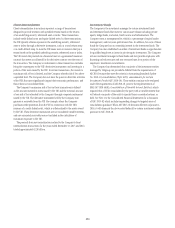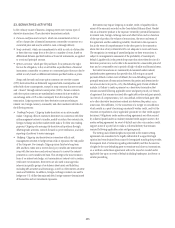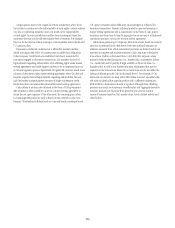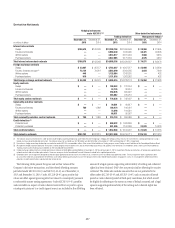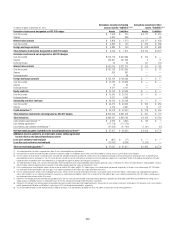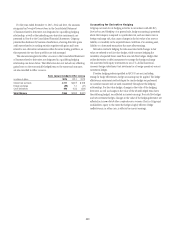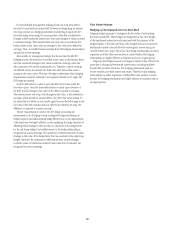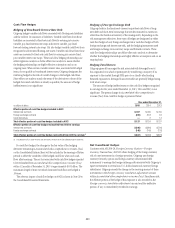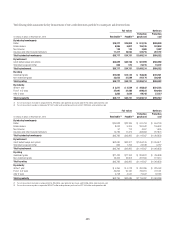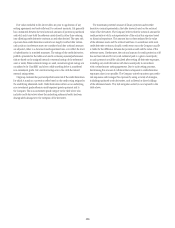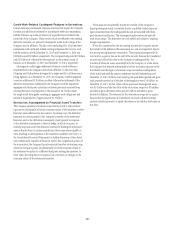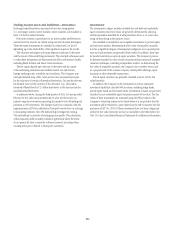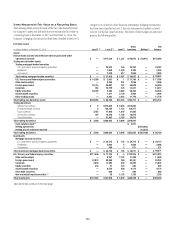Citibank 2015 Annual Report Download - page 262
Download and view the complete annual report
Please find page 262 of the 2015 Citibank annual report below. You can navigate through the pages in the report by either clicking on the pages listed below, or by using the keyword search tool below to find specific information within the annual report.244
For derivatives designated as net investment hedges, Citigroup follows the
forward-rate method outlined in ASC 815-35-35-16 through 35-26. According
to that method, all changes in fair value, including changes related to the
forward-rate component of the foreign currency forward contracts and the
time value of foreign currency options, are recorded in the Foreign currency
translation adjustment account within Accumulated other comprehensive
income (loss).
For foreign-currency-denominated debt instruments that are designated
as hedges of net investments, the translation gain or loss that is recorded in
the Foreign currency translation adjustment account is based on the spot
exchange rate between the functional currency of the respective subsidiary
and the U.S. dollar, which is the functional currency of Citigroup. To the
extent the notional amount of the hedging instrument exactly matches the
hedged net investment and the underlying exchange rate of the derivative
hedging instrument relates to the exchange rate between the functional
currency of the net investment and Citigroup’s functional currency (or, in the
case of a non-derivative debt instrument, such instrument is denominated in
the functional currency of the net investment), no ineffectiveness is recorded
in earnings.
The pretax gain (loss) recorded in the Foreign currency translation
adjustment account within Accumulated other comprehensive income
(loss), related to the effective portion of the net investment hedges, is
$2,475 million, $2,890 million and $2,370 million for the years ended
December 31, 2015 2014 and 2013, respectively.
Credit Derivatives
Citi is a market maker and trades a range of credit derivatives. Through these
contracts, Citi either purchases or writes protection on either a single name
or a portfolio of reference credits. Citi also uses credit derivatives to help
mitigate credit risk in its corporate and consumer loan portfolios and other
cash positions, and to facilitate client transactions.
Citi monitors its counterparty credit risk in credit derivative contracts. As
of December 31, 2015 and December 31, 2014, approximately 98% of the
gross receivables are from counterparties with which Citi maintains collateral
agreements. A majority of Citi’s top 15 counterparties (by receivable balance
owed to Citi) are banks, financial institutions or other dealers. Contracts
with these counterparties do not include ratings-based termination events.
However, counterparty ratings downgrades may have an incremental effect by
lowering the threshold at which Citi may call for additional collateral.
The range of credit derivatives entered into includes credit default swaps,
total return swaps, credit options and credit-linked notes.
A credit default swap is a contract in which, for a fee, a protection seller
agrees to reimburse a protection buyer for any losses that occur due to a
predefined credit event on a reference entity. These credit events are defined
by the terms of the derivative contract and the reference credit and are
generally limited to the market standard of failure to pay on indebtedness
and bankruptcy of the reference credit and, in a more limited range of
transactions, debt restructuring. Credit derivative transactions that reference
emerging market entities will also typically include additional credit events
to cover the acceleration of indebtedness and the risk of repudiation or a
payment moratorium. In certain transactions, protection may be provided
on a portfolio of reference entities or asset-backed securities. If there is no
credit event, as defined by the specific derivative contract, then the protection
seller makes no payments to the protection buyer and receives only the
contractually specified fee. However, if a credit event occurs as defined in
the specific derivative contract sold, the protection seller will be required to
make a payment to the protection buyer. Under certain contracts, the seller of
protection may not be required to make a payment until a specified amount
of losses has occurred with respect to the portfolio and/or may only be
required to pay for losses up to a specified amount.
A total return swap typically transfers the total economic performance of
a reference asset, which includes all associated cash flows, as well as capital
appreciation or depreciation. The protection buyer receives a floating rate of
interest and any depreciation on the reference asset from the protection seller
and, in return, the protection seller receives the cash flows associated with
the reference asset plus any appreciation. Thus, according to the total return
swap agreement, the protection seller will be obligated to make a payment
any time the floating interest rate payment plus any depreciation of the
reference asset exceeds the cash flows associated with the underlying asset.
A total return swap may terminate upon a default of the reference asset or
a credit event with respect to the reference entity subject to the provisions of
the related total return swap agreement between the protection seller and the
protection buyer.
A credit option is a credit derivative that allows investors to trade or hedge
changes in the credit quality of a reference entity. For example, in a credit
spread option, the option writer assumes the obligation to purchase or sell
credit protection on the reference entity at a specified “strike” spread level.
The option purchaser buys the right to sell credit default protection on the
reference entity to, or purchase it from, the option writer at the strike spread
level. The payments on credit spread options depend either on a particular
credit spread or the price of the underlying credit-sensitive asset or other
reference. The options usually terminate if a credit event occurs with respect
to the underlying reference entity.
A credit-linked note is a form of credit derivative structured as a debt
security with an embedded credit default swap. The purchaser of the note
effectively provides credit protection to the issuer by agreeing to receive a
return that could be negatively affected by credit events on the underlying
reference credit. If the reference entity defaults, the note may be cash settled
or physically settled by delivery of a debt security of the reference entity. Thus,
the maximum amount of the note purchaser’s exposure is the amount paid
for the credit-linked note.


